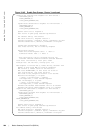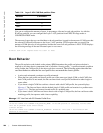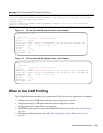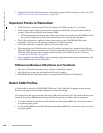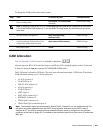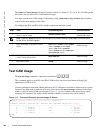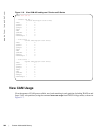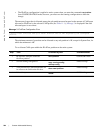
288 | Content Addressable Memory
www.dell.com | support.dell.com
• Optimize the VLAN ACL Group feature, which permits group VLANs for IP egress ACLs. See CAM
profile for the VLAN ACL group feature on page 299.
Important Points to Remember
• CAM Profiling is available on the E-Series TeraScale with FTOS versions 6.3.1.1 and later.
• All line cards within a single system must have the same CAM profile; this profile must match the
system CAM profile (the profile on the primary RPM).
• FTOS automatically reconfigures the CAM profile on line cards and the secondary RPM to match
the system CAM profile by saving the correct profile on the card and then rebooting it.
• The CAM configuration is applied to entire system when you use CONFIGURATION mode
commands. You must save the running-configuration to affect the change.
• All CAM configuration commands require you to reboot the system.
• When budgeting your CAM allocations for ACLs and QoS configurations, remember that ACL and
QoS rules might consume more than one CAM entry depending on complexity. For example, TCP and
UDP rules with port range options might require more than one CAM entry. See Pre-calculating
Available QoS CAM Space on page 874.
• After you install a secondary RPM, copy the running-configuration to the startup-configuration so that
the new RPM has the correct CAM profile.
Differences Between EtherScale and TeraScale
• Only one CAM profile and microcode is available on EtherScale systems.
• Only EtherScale systems can sub-partition the IPv4ACL partition.
• Both EtherScale and TeraScale systems can sub-partition the IPv4Flow CAM partition.
Select CAM Profiles
A CAM profile is selected in CONFIGURATION mode. The CAM profile is applied to entire system,
however, you must save the running-configuration to affect the change.
All components in the chassis must have the same CAM profile and microcode. The profile and microcode
loaded on the primary RPM determines the profile that is required on all other chassis components.
• If a newly installed line card has a profile different from the primary RPM, the card reboots so that it
can load the proper profile.
• If a the standby RPM has a profile different from the primary RPM, the card reboots so that it can load
the proper profile.



